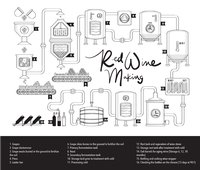Délestage, An Important Winemaking Technique
 The term délestage often comes up when discussing wines and winemaking techniques, so it seems appropriate to define this term for Carl’s Corner readers. The word is pronounced “day-leh-staj” and literally means “making lighter” in French, referring to the process of making the grape juice less dense by separating the grape solids (skins and seeds). Délestage is a technique used in fermenting red grapes that helps produce softer wines with less astringent tannins, more fruit character, and a mellower finish.
The term délestage often comes up when discussing wines and winemaking techniques, so it seems appropriate to define this term for Carl’s Corner readers. The word is pronounced “day-leh-staj” and literally means “making lighter” in French, referring to the process of making the grape juice less dense by separating the grape solids (skins and seeds). Délestage is a technique used in fermenting red grapes that helps produce softer wines with less astringent tannins, more fruit character, and a mellower finish.
Two good articles that describe the délestage technique are referenced below. They describe in detail the three main techniques that winemakers use during the traditional fermentation and maceration process to extract phenolic compounds from grapes. These phenolic compounds form the basis for a wine’s color, contribute some characteristic flavors, and introduce the tannins that serve as natural antioxidants.
A punch-down is the most common method used to promote extraction of phenolic compounds during maceration. Crushed grapes are placed in a bin or tank where juice comes in contact with the darkly colored skins. The juice begins to absorb color - remember, most red grapes have colorless juice and the color that eventually ends up in the wine is extracted from the skins. Punch-downs have been used for ages. A tool with a long handle attached to a perpendicular flattened plate, often perforated with holes (kind of like an oversized potato masher), is used to push the cap of grape skins that form on top of the fermenting mixture back down into the liquid portion. This mixing and stirring motion has several benefits, including better extraction of phenolic compounds, introduction of oxygen (air) to the mixture (critical to yeast health and activity), and helping to cool the mixture to keep fermentation temperature from rising too high. When doing punch-downs, grape juice, skins, and seeds all remain in contact during fermentation.
Pump-overs, often used in larger commercial operations, are a second common method used to promote extraction during maceration. Juice from the bottom of the fermentation vessel is drained into a small tank and is then pumped back into the fermentation vessel, splashing over the top of the grape skin cap that forms over the juice. This “fire hose” approach breaks up the cap and provides the same benefits noted above. Pump-overs are most often employed when larger volume tanks and vessels are used for fermentation and maceration. An added benefit for pump-overs is that most winemakers use a filter screen when draining the juice to separate a portion of seeds. This helps to reduce the amount of tart, astringent seed tannins that get extracted into the wine.
Délestage is often called “rack-and-return”, essentially a two-step process in which fermenting red wine juice is racked or drained from the grape solids into a separate vessel. This is sort of like a pump-over, except the juice is removed and returned only after a period of time (usually a few hours), not immediately. This allows the juice and solids to be separated. When the juice is returned to the solids in the fermentation vessel, the skins and other solids re-hydrate. Délestage is usually done on a daily basis several times during fermentation.
The primary benefit of délestage is exposure of the fermentation juice to air (oxygen). This promotes healthy yeast activity and softens extracted tannins through oxidation. The traditional methods of pump-overs and punch-downs allow all or most of the fermentation mixture to remain under a protective layer of carbon dioxide gas (a by-product of fermentation) that minimizes the amount of air contact. Délestage, however, removes the juice from this carbon dioxide layer and allows much greater contact with air (oxygen). Thus, more softening of the tannins will occur earlier in the winemaking process.
Another benefit of délestage can be the removal of grape seeds to minimize extraction of harsh tannins. During fermentation, seeds fall and form a layer at the bottom of the vessel while the grape skin cap rises to the surface of the liquid. While juice is drained or racked away, the skin cap settles gently on top of the seed layer. The winemaker can then physically remove some of the bottom layer of seeds before returning the juice to the vessel. This process is repeated daily, or as often as the winemaker thinks appropriate, until the end of fermentation.
Grape varieties that have thicker, darker skins and/or seeds from which harsher, more astringent tannins can be extracted are often subjected to the délestage technique. Hot, arid growing conditions tend to promote thicker grape skins and these can produce more color, but also more tannins. This is a common occurrence here in Texas, so winemakers often embrace the use of délestage to soften the tannins in their wines and provide a finish that is more mellow and gentle on the palate. This is a great topic to explore the next time you visit a Texas winemaker or knowledgeable tasting room associate.
References
Déléstage Fermentation: From Bitter to Better Reds. by Richard Leahy, Vineyard & Winery Management. Sept./Oct. 2000, Vol. 26, No. 5.
Déléstage Fermentation: Techniques, by Daniel Pambianchi,
https://winemakermag.com/technique/237-delestage-fermentation-techniques
